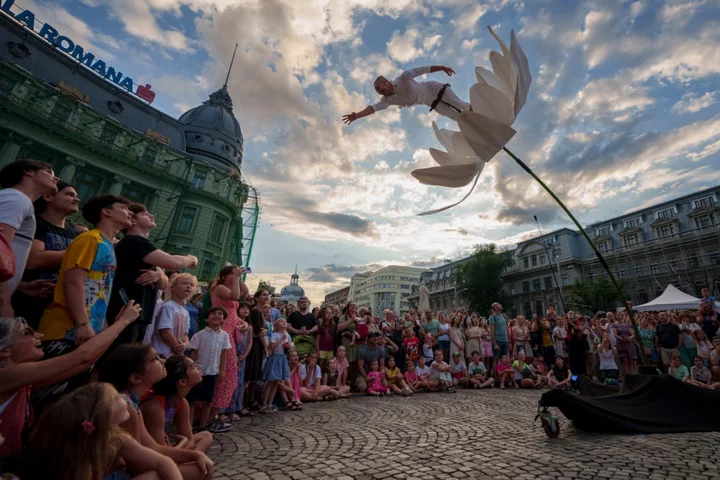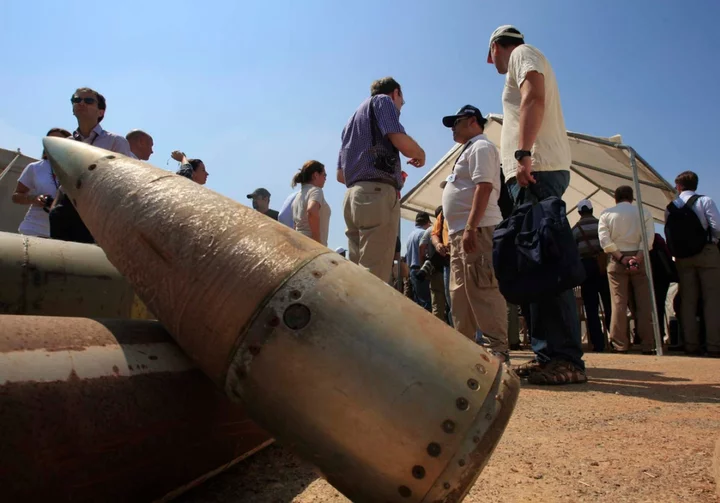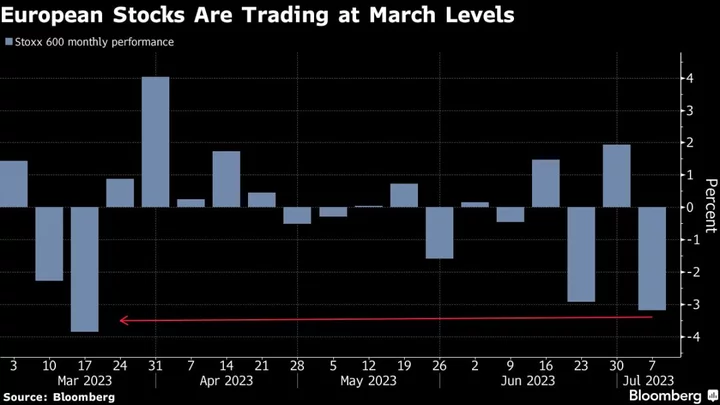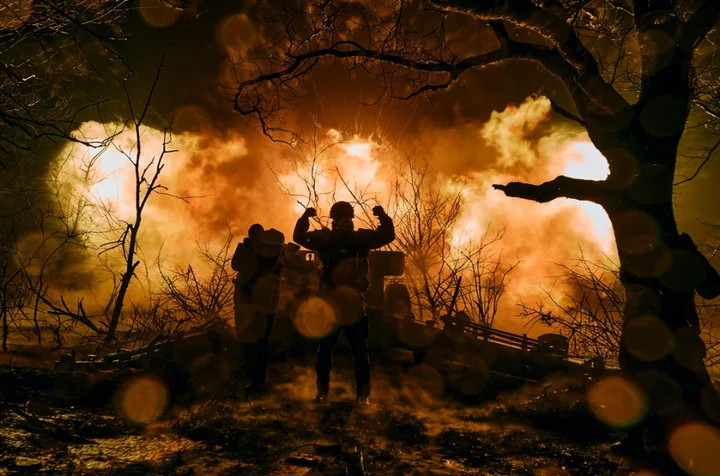
AP's Global Week in Pictures: July 1 - 7
July 1 - 7, 2023 Street artists performed across the Romanian capital, French protesters burned buses after a teenager was shot by police, Russia continued to attack Ukraine, Palestinians buried their dead after Israeli soldiers drove thousands form their homes, and people tried to stay out of the sun on the hottest days on human record. In the world of sports, cycles wizzed through forests on their Tour de France. This photo gallery highlights some of the most compelling images from around the world made or published by the Associated Press in the past week. The selection was curated by AP photo editor Leslie Mazoch in Mexico City. Follow AP visual journalism: Instagram: https://www.instagram.com/apnews/ AP Images on Twitter: https://twitter.com/AP_Images Read More Ukraine war’s heaviest fight rages in east - follow live Charity boss speaks out over ‘traumatic’ encounter with royal aide
2023-07-08 10:20

Rutte Coalition Falls Over Asylum Crisis as Dutch Face Vote
Dutch Prime Minister Mark Rutte’s government collapsed over a migration policy dispute, pointing the Netherlands toward an early
2023-07-08 05:59

Is Taylor Swift snubbing Canada?
Swift has tour stops in South America, Asia and Australia, but not Canada. Is there bad blood?
2023-07-08 05:46

New satellite images show mystery ‘white objects’ on roof of Zaporizhzhia nuclear plant
New satellite images depict “white objects” on the roof of the Zaporizhzhia nuclear plant, days after Ukrainian president Volodymyr Zelensky alleged that Russia had planted explosives there. Russian troops seized Europe’s largest nuclear facility on 5 March, shortly after its invasion began in February. The new photos were captured by satellite imagery company Planet Labs on Wednesday (5 July), showing five white shapes topping the plant at 7.51am UTC (8.51am BST). Notably, an image captured earlier at 5.27am UTC (6.27am BST) shows none. However, the Royal United Services Institute (RUSI) has expressed that whilst unexplained, the “white objects” are “not conclusive” of Russian military activity at the plant. "Based on the imagery available, some changes can be observed at the ZNPP power plant on 5 July, with white objects observed on the roof of one of the buildings”, Joe Byrne, a research fellow on Open Source Intelligence and Analysis at the RUSI told The Independent. “However, this is not conclusive evidence of any Russian military activity designed to damage the plant,” he added. “More evidence, including and on the site access by IAEA monitors is needed to fully assess the situation." Darya Dolzikova, a research fellow in Proliferation and Nuclear Policy, noted the changes are “hard to judge” from the images. "It’s hard to judge from the imagery what the changes on the roofs show - including whether these are in any way related to the explosive devices that Ukrainian intelligence said may be present on reactor roofs at the ZNPP. “But the sourcing of independent, reliable imagery is important and can help in verifying claims of what is happening at the ZNPP”, Ms Dolzikova said. “However, the images - including the challenges related to verifying what they actually show - also once again stress the importance of granting the IAEA all the access that it is asking for at the ZNPP - including to the roofs of reactors 3 and 4 - so it can verify the presence or absence of explosives at the facility." On Tuesday), Mr Zelensky alleged that Russia has planted explosives on the nuclear power plant to simulate an attack, accusing Russian forces of planning to commit a “new evil” following the alleged attack on Kakhovka hydroelectric power plant in June 2023. The destruction of the Kakhovka hydroelectric station and dam triggered mass flooding and environmental havoc, forcing thousands of residents to flee their homes. Ukraine blames the explosion on Russia. “Now we have information from our intelligence that the Russian military has placed objects resembling explosives on the roof of several power units of the Zaporizhzhia nuclear power plant,” Mr Zelensky said in his nightly video address on Tuesday. “Perhaps to simulate an attack on the plant. Perhaps they have some other scenario. But in any case, the world sees – can’t but see – that the only source of danger to the Zaporizhzhia nuclear power plant is Russia and no one else.” Read More Ukraine-Russia war – live: Putin’s troops ‘suffer new losses near Bakhmut’ as counteroffensive continues Preparing for an attack by Russia, Zaporizhzhia’s residents cannot escape the threat of nuclear disaster Zelensky says Russia has planted explosives on Ukraine nuclear plant Ukraine and Russia trade accusations of imminent attack on Europe's largest nuclear plant. After the flood: The nightmare is just beginning for those left to rebuild after the Ukraine dam explosion Russia reducing military presence and personnel at Zaporizhzhia nuclear plant, says Ukraine The Body in the Woods | An Independent TV Original Documentary The harrowing discovery at centre of The Independent’s new documentary
2023-07-08 00:15

European shares turn positive as slow U.S. job growth eases rate hike fears
By Matteo Allievi and Shubham Batra (Reuters) -European shares turned positive on Friday after U.S. job growth slowed more than
2023-07-07 21:59

Irish Rail warns of fake ticket inspectors
Members of the public are reported as wearing unofficial, hi-vis vests onboard trains in Dublin.
2023-07-07 19:29

What are cluster bombs and why is it controversial for the US to send them to Ukraine?
The United States is expected to announce it is sending cluster munitions to Ukraine to help its military push back Russian forces entrenched along the front lines. The administration of Joe Biden is set to say that it will send thousands of them as part of a new military aid package worth $800m (£630m). The move will likely trigger outrage from some allies and humanitarian groups that have long opposed the use of cluster bombs. Proponents argue that both Russia and Ukraine have already been using the controversial weapon in Ukraine and that the munitions the US will provide have a reduced dud rate, meaning there will be far fewer unexploded rounds that can result in unintended civilian deaths. Here is a look at what cluster munitions are, where they have been used and why the U.S. plans to provide them to Ukraine now. What is a cluster munition? A cluster munition is a bomb that opens in the air and releases smaller "bomblets" across a wide area. The bomblets are designed to take out tanks and equipment, as well as troops, hitting multiple targets at the same time. The munitions are launched by the same artillery weapons that Western allies have already provided to Ukraine for the war — such as howitzers — and the type of cluster munition that the US is planning to send is based on a common 155 mm shell that is already widely in use across the battlefield. Why are they so controversial? In previous conflicts, cluster munitions have had a high dud rate, which meant that thousands of the smaller unexploded bomblets remained behind and killed and maimed people decades later. The US last used its cluster munitions in battle in Iraq in 2003, and decided not to continue using them as the conflict shifted to more urban environments with more dense civilian populations. On Thursday, Brigadier General Pat Ryder – the Pentagon press secretary – said the US Defense Department has "multiple variants" of the munitions and "the ones that we are considering providing would not include older variants with [unexploding] rates that are higher than 2.35 per cent." A convention banning the use of cluster bombs has been joined by more than 120 countries, which agreed not to use, produce, transfer or stockpile the weapons and to clear them after they've been used. The US, Russia and Ukraine haven't signed on. Why provide them now? For more than a year the US has dipped into its own stocks of traditional 155 howitzer munitions and sent more than two million rounds to Ukraine. Allies across the globe, including the UK, have provided hundreds of thousands more. A 155 mm round can strike targets 15 to 20 miles (24 to 32 kilometres) away, making them a munition of choice for Ukrainian ground troops trying to hit enemy targets from a distance. Ukrainian forces are burning through thousands of the rounds a day battling the Russians. Yehor Cherniev, a member of Ukraine's parliament, told reporters at a German Marshall Fund event in the US this spring that Kyiv would likely need to fire 7,000 to 9,000 of the rounds daily in intensified counteroffensive fighting. Providing that many puts substantial pressure on U.S. and allied stocks. The cluster bomb can destroy more targets with fewer rounds, and since the US hasn't used them in conflict since Iraq, it has large amounts of them in storage it can access quickly, said Ryan Brobst, a research analyst for the Foundation for Defense of Democracies. A March 2023 letter from top House and Senate Republicans to the Biden administration said the US may have as many as three million cluster munitions available for use, and urged the White House to send the munitions to alleviate pressure on American war supplies. "Cluster munitions are more effective than unitary artillery shells because they inflict damage over a wider area," Mr Brobst said. "This is important for Ukraine as they try to clear heavily fortified Russian positions." Tapping into the US stores of cluster munitions could address Ukraine's shell shortage and alleviate pressure on the 155 mm stockpiles in the US and elsewhere, Mr Brobst said. Is using cluster bombs a war crime? Use of cluster bombs itself does not violate international law, but using them against civilians can be a violation. As in any strike, determining a war crime requires looking at whether the target was legitimate and if precautions were taken to avoid civilian casualties. "The part of international law where this starts playing [a role], though, is indiscriminate attacks targeting civilians," Human Rights Watch's associate arms director Mark Hiznay said. "So that's not necessarily related to the weapons, but the way the weapons are used." Where have cluster bombs been used? The bombs have been deployed in many recent conflicts. The US initially considered cluster bombs an integral part of its arsenal during the invasion of Afghanistan that began in 2001, according to Human Rights Watch (HRW). The group estimated that the US-led coalition dropped more than 1,500 cluster bombs in Afghanistan during the first three years of the conflict. The Defense Department had been due to stop use of any cluster munitions with a rate of unexploded ordnance greater than 1 per cent, by 2019. But the Trump administration rolled back that policy, allowing commanders to approve use of such munitions. Syrian government troops have often used cluster munitions — supplied by Russia — against opposition strongholds during that country's civil war, frequently hitting civilian targets and infrastructure. And Israel used them in civilian areas in south Lebanon, including during the 1982 invasion. During the month-long 2006 war with Hezbollah, HRW and the United Nations accused Israel of firing as many as four million cluster munitions into Lebanon. That left unexploded ordnance that threatens Lebanese civilians to this day. The Saudi-led coalition in Yemen has been criticized for its use of cluster bombs in the war with the Iran-backed Houthi rebels that has ravaged the southern Arabian country. In 2017, Yemen was the second deadliest country for cluster munitions after Syria, according to the UN. Children have been killed or maimed long after the munitions originally fell, making it difficult to know the true toll. In the 1980s, the Russians made heavy use of cluster bombs during their 10-year invasion of Afghanistan. As a result of decades of war, the Afghan countryside remains one of the most heavily mined countries in the world. Associated Press Read More The Body in the Woods | An Independent TV Original Documentary The harrowing discovery at centre of The Independent’s new documentary Biden is considering sending controversial cluster munitions to help Ukraine Muslims across Pakistan hold anti-Sweden rallies to denounce burning of Islam's holy book Ukraine claims new gains made against Russia’s troops near Bakhmut - live
2023-07-07 19:25

Ukraine Recap: Zelenskiy to Discuss Grain Deal With Erdogan
Ukraine President Volodymyr Zelenskiy is expected to meet President Recep Tayyip Erdogan in Istanbul late on Friday as
2023-07-07 19:20

European Stocks Are Steady Before US Jobs Data; Miners Climb
European shares were little changed on Friday as investors awaited key US jobs data for further clues on
2023-07-07 18:47

Chinese Foreign Minister’s Unusual 12-Day Absence Draws Scrutiny
Chinese Foreign Minister Qin Gang has been absent from public view for 12 days, an usual absence for
2023-07-07 18:47

Ukraine-Russia war – live: Putin’s troops ‘suffer new losses near Bakhmut’ as counteroffensive continues
Ukrainian troops have advanced by more than a kilometre in the last day against Russian forces near the eastern city of Bakhmut, a military spokesperson said on Friday. His comments were the latest by Kyiv signalling that the counteroffensive it launched in early June is gradually making progress although Russian accounts of fighting in the Bakhmut sector differ from Ukraine’s. “The defence forces continue to hold the initiative there, putting pressure on the enemy, conducting assault operations, advancing along the northern and southern flanks,” Serhiy Cherevatyi told Ukrainian television. “In particular, over the past day, they have advanced more than one kilometre (0.62 mile).” Elsewhere, the president of Belarus, Alexander Lukashenko said there were “no war heroes” following Wagner’s attempted coup in Moscow after Vladimir Putin was hailed a hero by Russian state TV. Mr Lukashenko, ally to the president, told the BBC: “I think that no one came out of that situation a hero. “Not Prigozhin, not Putin, not Lukashenko. There were no heroes. And the lesson from this? If we create armed groups like this, we need to keep an eye on them and pay serious attention to them.” Read More Inside Vladimir Putin’s luxury armoured train – that has its own beauty salon Wigs, gold bars and pictures of severed heads: Inside Wagner boss’s lavish Russian mansion Why the US is willing to send Ukraine cluster munitions now How many casualties has Russia suffered in Ukraine?
2023-07-07 17:57

UBS Revamps Leadership in Mideast Wealth Unit, Latin America
UBS Group AG revamped the leadership of its Middle East wealth unit and named new management for its
2023-07-07 17:20
